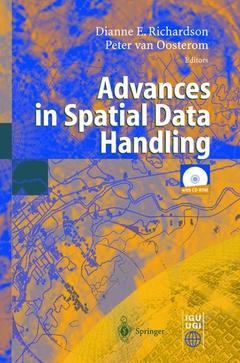Description
Advances in Spatial Data Handling, Softcover reprint of the original 1st ed. 2002
10th International Symposium on Spatial Data Handling
Coordinators: Richardson Dianne, Oosterom Peter van
Language: French
Subjects for Advances in Spatial Data Handling:
Advances in Spatial Data Handling
Publication date: 11-2012
562 p. · 15.5x23.5 cm · Paperback
Publication date: 11-2012
562 p. · 15.5x23.5 cm · Paperback
Advances in spatial data handling (with CD-ROM)
Publication date: 07-2002
562 p. · 15.5x23.5 cm · Hardback
Publication date: 07-2002
562 p. · 15.5x23.5 cm · Hardback
Description
/li>Contents
/li>Comment
/li>
This book, entitled Advances in Spatial Data Handling, is a compendium of papers resulting from the International Symposium on Spatial Data Handling (SDH), held in Ottawa, Canada, July 9-12, 2002. The SDH conference series has been organised as one of the main activities of the International Geographical Union (IGU) since it was first started in Zurich in 1984. In the late 1990?s the IGU Commission of Geographic Information Systems was discontinued and a study group was formed to succeed it in 1997. Much like the IGU Commission, the objectives of the Study Group are to create a network of people and research centres addressing geographical information science and to facilitate exchange of information. The International Symposium on Spatial Data Handling, which is the most important activity of the IGU Study Group, has, throughout its 18 year history been highly regarded as one of the most important GIS conferences in the world.
A Decision Tree for Multi-Layered Spatial Data.- Computational and Visual Support for Geographical Knowledge Construction: Filling in the Gaps Between Exploration and Explanation.- Polygonization of Point Clusters through Cluster Boundary Extraction for Geographical Data Mining.- The Impact of Filtering on Spatial Continuous Queries.- An Object Model for Geologic Map Information.- Indexing and Browsing Digital Maps with Intelligent Thumbnails.- Modelling and Manipulating Multiple Representations of Spatial Data.- Terrain Modelling Based on Contours and Slopes.- Siting Observers on Terrain.- An Agent-Based Framework for Polygonal Subdivision Generalisation.- Template Matching in Support of Generalisation of Rural Buildings.- Minimising Positional Errors in Line Simplification Using Adaptive Tolerance Values.- A New Merging Process for Data Integration Based on the Discrete Fréchet Distance.- Above-Ground Biomass Estimation of Successional and Mature Forests Using TM Images in the Amazon Basin.- Grid Computing for Real Time Distributed Collaborative Geoprocessing.- The Balance Between Geometry and Topology.- STOQL: An ODMG-Based Spatio-Temporal Object Model and Query Language.- A Semantics for Version Queries in GIS Databases.- A Differential Spatio-temporal Model: Primitives and Operators.- A QTM-based Algorithm for Generation of the Voronoi Diagram on a Sphere.- The Dimensional Model: A Framework to Distinguish Spatial Relationships.- A Quantitative Description of Spatial Configurations.- Implementing Topological Predicates for Complex Regions.- Route Specifications with a Linear Dual Graph.- Projecting a Regular Grid onto a Sphere or Ellipsoid.- Creating Spatial Information: Commissioning the UK Land Cover Map 2000.- A Methodology for Updating Geographic DatabasesUsing Map Versions.- Revealing Uncertainty in Maps of Glacial Lake Algonquin.- Spatio-Temporal Methods to Reduce Data Uncertainty in Restricted Movement on a Road Network.- Quantifying Uncertainty of Digital Elevation Models Derived from Topographic Maps.- Detecting Building Alignments for Generalisation Purposes.- Temporal GIS and Statistical Modelling of Personal Lifelines.- Urban Simulation Using Neural Networks and Cellular Automata for Land Use Planning.- Creation of the Anamorphoses-Based 3D-Pyramidal Block-Diagrams.- Schematic Networks: An Algorithm and its Implementation.- Developing Lightweight, Data-Driven Exploratory Geo-visualisation Tools for the Web.- GAP-Tree Extensions Based on Skeletons.- Improving Automated Generalisation for On-Demand Web Mapping by Multiscale Databases.- Map Samples to Help GI Users Specify their Needs.- Representation of Map Objects with Semi-Structured Data Models.
The book brings together the science community that works in the area Geographic Information Systems and Remote Sensing
© 2024 LAVOISIER S.A.S.




